Picture 1
Portal:History of science/Picture/1

Joseph Wright of Derby's painting of The Alchemist in Search of the Philosopher's Stone (1771)
Picture 2
Portal:History of science/Picture/2
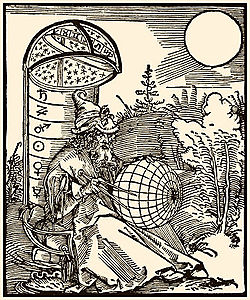
An engraving by Albrecht Dürer, from the title page of the Masha'allah ibn Atharī's astronomy treatise De scientia motus orbis (Latin version with engraving, 1504). As in many medieval illustrations, the compass here is an icon of religion as well as science, in reference to God as the architect of creation.
Picture 3
Portal:History of science/Picture/3

The frontispiece to Erasmus Darwin's evolution-themed poem The Temple of Nature shows a goddess pulling back the veil from nature (in the person of Artemis). Allegory and metaphor have often played an important role in the history of biology.
Picture 4
Portal:History of science/Picture/4

1675 image of a Chinese astronomer with an elaborate armillary sphere. In the 17th century, Chinese astronomers collaborated extensively with Jesuit scholars, who brought the Copernican and Tychonic systems from Europe.
Picture 5
Portal:History of science/Picture/5
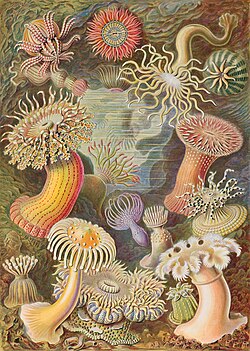
A lithograph from the 1904 edition of Ernst Haeckel's Kunstformen der Natur (Art Forms of Nature), depicting a variety of sea anemones.
Picture 6
Portal:History of science/Picture/6

The world map from Johannes Kepler's Rudolphine Tables (1627), incorporating many of the new discoveries of the Age of Exploration.
Picture 7
Portal:History of science/Picture/7

An anthropometric device (side view) by Major A.J.N. Tremearne designed "for measuring the living head" for "the use of anthropologists", invented in 1913 with later additions made at the suggestion of A. Keith and Karl Pearson.
Picture 8
Portal:History of science/Picture/8

An allegorical anatomy engraving from Andreas Vesalius's De humani corporis fabrica (1543), imparting a moral lesson on the consequences of evil and a physical lesson on the internal structure of the body.
Picture 9
Portal:History of science/Picture/9

Science, and particularly geometry and astronomy, was linked directly to the divine for most medieval scholars. The compass in this 13th century manuscript is a symbol of God's act of creation. God has created the universe after geometric and harmonic principles; to seek these principles was therefore to seek and worship God.
Picture 10
Portal:History of science/Picture/10

An Experiment on a Bird in the Air Pump is a 1768 oil-on-canvas painting by Joseph Wright of Derby which depicts a recreation of one of Robert Boyle's air pump experiments. It shows the reactions of a group of onlookers to an experiment performed by a natural philosopher in which a bird is deprived of oxygen. Scientific curiosity overcomes concern for the bird. The central figure looks out of the picture as if inviting the viewers participation in the outcome.
Picture 11
Portal:History of science/Picture/11

The iconic frontispiece to Johannes Kepler's 1627 Rudolphine Tables pays tribute to earlier great astronomers, including Copernicus, Ptolemy and most prominently Tycho Brahe. It was used in 2005 as the emblem for the joint meeting of the History of Science Society and the Society for the History of Technology.
Picture 12
Portal:History of science/Picture/12

Charles Darwin has been caricatured as a monkey innumerable times since the publications of Origin of Species and Descent of Man.
Picture 13
Picture 14
Portal:History of science/Picture/14
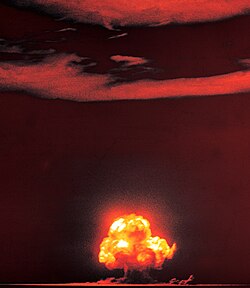
This famous color photograph of the "Trinity" shot, the first nuclear test explosion, was taken by Jack Aeby on July 16, 1945. Aeby was a member of the Special Engineering Detachment at Los Alamos National Laboratory, working under the aegis of the Manhattan Project.
Picture 15
Portal:History of science/Picture/15

Francis Galton was an English polymath known for his work in heredity, eugenics, and statistics. This photograph of Galton (age 73) was created upon his visit to Alphonse Bertillon's anthropometry laboratory in 1893. It serves as a good example of Bertillon's identification technology, which intended for the prosecution of criminals. Ironically, fingerprinting, a technique Galton transformed into a rigorously scientific one, eventually replaced Bertillon's system.
Picture 16
Portal:History of science/Picture/16

This armillary sphere is one of many astronomical instruments designed by Danish astronomer Tycho Brahe. In his Astronomiæ Instauratæ Mechanica (1598), he describe the unique features of this particular armillary device, the "equatorial armillary instrument." It featured a balanced design that circumvented problems in earlier spheres in which the weight of the poles would pull the rotating planes into a rest position.
Picture 17
Portal:History of science/Picture/17
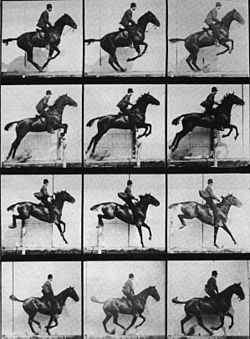
This famous sequence of photographs, depicting a horse in motion, was created by Eadweard Muybridge in 1904. His technique involved multiple cameras, linked by an electrical trigger, to capture many images in rapid succession. Muybridge demonstrated this and many other sets of motion photographs to the public using his zoopraxiscope, a precursor of motion pictures.
Picture 18
Portal:History of science/Picture/18
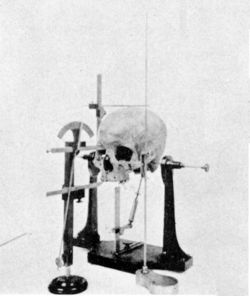
Craniometry, the technique of measuring the bones of the skull, was once intensively practiced in anthropology/ethnology. Through the 20th century, craniometry—especially measurements of brain volume—was a matter of considerable; among other misuses, the apparent scientific support of craniometric theories for racism was used to the support the racist ideologies, and ultimately genocidal policies, of the Nazi party.
Picture 19
Portal:History of science/Picture/19

In this set of drawings from 1616, Galileo Galilei recorded the uneven curve of the Sun's light along the lunar surface, indicating variations in elevation. Galileo's telescope observations of the Moon and other heavenly bodies helped to convince 17th century scholars to abandon the notion of the heavens as perfect and unchanging. Before the rise of telescopic observations, the Moon was still considered by some Jesuit astronomers to be flat, with the visible spots caused by variations in density or optical phenomena. Galileo had planned a more extensive program of observations and illustrations, finding little resistance to a rough Moon, made no further lunar drawings after these.
Picture 20
Portal:History of science/Picture/20
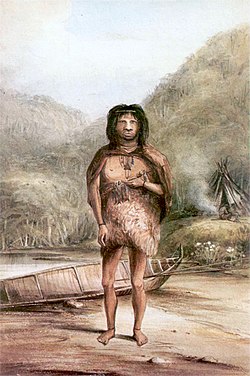
This watercolor depicts a native from the Tierra del Fuego, from around the time that Charles Darwin was on his Voyage of the Beagle (1830s). Darwin was taken aback at the crude savagery of the natives, in stark contrast to the civilised behaviour of the three Fuegians they were returning as missionaries (who had been given the names York Minster, Fuegia Basket and Jemmy Button). He described his first meeting with the native Fuegians as being "without exception the most curious and interesting spectacle I ever beheld: I could not have believed how wide was the difference between savage and civilised man: it is greater than between a wild and domesticated animal, inasmuch as in man there is a greater power of improvement." In contrast, he said of Jemmy that "It seems yet wonderful to me, when I think over all his many good qualities, that he should have been of the same race, and doubtless partaken of the same character, with the miserable, degraded savages whom we first met here." Four decades later, in The Descent of Man, he would use his impressions from this period as evidence that man had evolved civilization from a more primitive state.
Picture 21
Portal:History of science/Picture/21
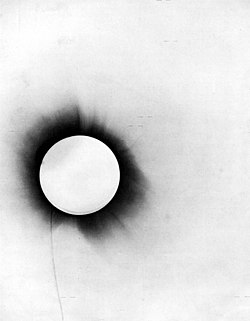
During the solar eclipse of May 29, 1919, several teams of scientists attempted to verify Einstein's prediction of the bending of light around the sun using photographic measurements. This negative, taken from Arthur Eddington's report of the expedition to the African island Príncipe, was presented as part of a successful test of general relativity, based on the positions of stars near the eclipsed sun. The original caption reads:
- In Plate 1 is given a half-tone reproduction of one of the negatives taken with the 4-inch lens at Sobral. This shows the position of the stars, and, as far as possible in a reproduction of this kind, the character of the images, as there has been no retouching. A number of photographic prints have been made and applications for these from astronomers, who wish to assure themselves of the quality of the photographs, will be considered as as far as possible acceded to.
Picture 22
Portal:History of science/Picture/22
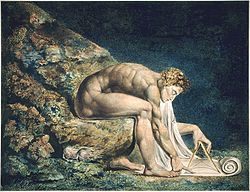
Poet and artist William Blake criticized Newton and like-minded philosophers such as Locke and Bacon for relying solely on reason.
Blake's 1795 print Newton is a demonstration of his opposition to the "single-vision" of scientific materialism: the great philosopher-scientist is shown utterly isolated in the depths of the ocean, his eyes (only one of which is visible) fixed on the compasses with which he draws on a scroll. His concentration is so fierce that he seems almost to become part of the rocks upon which he sits.
Picture 23
Portal:History of science/Picture/23

The Flammarion woodcut is an enigmatic woodcut by an unknown artist. It is referred to as the "Flammarion woodcut" because its first documented appearance is in page 163 of Camille Flammarion's L'atmosphère: météorologie populaire ("The Atmosphere: Popular Meteorology," Paris, 1888).
The woodcut depicts a man, dressed as a medieval pilgrim and carrying a pilgrim's staff, peering through the sky as if it were a curtain to look at the inner workings of the universe. One of the elements of the cosmic machinery bears a strong resemblance to traditional pictorial representations of the "wheel in the middle of a wheel" described in the visions of the prophet Ezekiel (see Merkabah). The caption in Flammarion's book translates as "A missionary of the Middle Ages tells that he had found the point where the sky and the Earth touched..." The image accompanies a text which reads, in part, "What, then, is this blue sky, which certainly does exist, and which veils from us the stars during the day?" The woodcut is often described as being medieval due to its visual style, its fanciful vision of the world, and to what appears to be a depiction of a flat Earth.
Picture 24
Portal:History of science/Picture/24
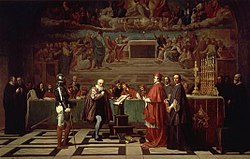
Galileo before the Holy Office, a 19th century painting by Joseph-Nicolas Robert-Fleury, is a classic expression of the conflict thesis regarding the relationship between religion and science. Galileo is shown valiantly defending himself and his Copernican views before the hostile Inquisition, which will soon declare his science to be heresy. In the 19th century, the Galileo affair, in somewhat distorted form, became a central example of the supposedly continual and inevitable struggle between science and religion.
Picture 25
Portal:History of science/Picture/25

This 1885 portrait of Louis Pasteur, by Albert Edelfelt, is a classic depiction of the pure scientist; the painting was emulated in print as well, and it adorns the cover of the first critical biography of the great chemist. Within his lifetime, Pasteur became an heroic figure within French culture, and historians' attempts to dispel some of the "Pasteurian myths" were initially met with strong resistance.
Picture 26
Portal:History of science/Picture/26

This iconographic French tapestry from the early 16th century depicts the muse Astronomia consulting with an astronomer, possibly Ptolemy. The tapestry resides in the Röhsska Konstslöjdmuseet, but its origins are unknown.
Picture 27
Portal:History of science/Picture/27

Ernst Haeckel, the great populariser of Charles Darwin's theory of evolution, was the first to use a literal tree of life to express evolutionary relationships based on common descent. This version comes from his 1866 General Morphology; several different versions, some highly elaborate and artistic, are found in other Haeckel works. The icon of a tree of life has been used widely since that time; some modern versions include a tangled root system to represent the effects of horizontal gene transfer and symbiogenesis early in evolutionary history.
Picture 28
Portal:History of science/Picture/28

Astronaut Buzz Aldrin, Apollo Lunar Module pilot, walks on the surface of the Moon near the leg of the Lunar Module Eagle during the Apollo 11 extravehicular activity (EVA). Astronaut Neil A. Armstrong, commander, took this photograph with a 70mm lunar surface camera. While astronauts Armstrong and Aldrin descended in the Eagle to explore the Sea of Tranquility region of the Moon, astronaut Michael Collins, command module pilot, remained with the Command and Service Module Columbia in lunar orbit.
Picture 29
Portal:History of science/Picture/29

Part of Charles Babbage's Difference Engine was assembled after his death by Babbage's son, using parts found in his laboratory. The brass parts were machined by the toolmaker Joseph Clement. Babbage never completed his difference engine, partly due to problems with friction and machining accuracy, but also because he kept changing the design. Henry Provost Babbage inherited the pieces following his father's death in 1871, and some years later in 1879 he assembled several working sections of the full machine. Possibly as many as seven assembled sections exist. This portion, in the Whipple Museum of the History of Science of the University of Cambridge, demonstrates how the addition and carry mechanism works.
Picture 30
Portal:History of science/Picture/30
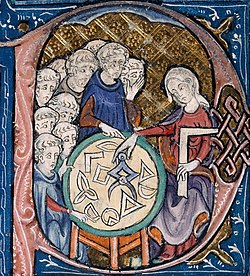
In this detail from an early 14th century copy of Euclid's Elements, a woman is shown teaching geometry. It is a detail of a scene in the bowl of the letter 'P'; the woman, with a set-square and dividers, uses a compass to measure distances on a diagram. In her left hand she holds a square, an implement for testing or drawing right angles. She is watched by a group of students. In images from the Middle Ages, it is unusual to see women represented as teachers, in particular when the students appear to be monks. She may be the personification of Geometry.
Picture 31
Portal:History of science/Picture/31

A Philosopher Lecturing on the Orrery (sometimes called simply The Orrery) is a painting (oil on canvas, ca. 1766) by Joseph Wright of Derby depicting a public lecture about a model Solar System, with a lamp—in place of the Sun—illuminating the faces of the audience. Wright captures the spirit of the Enlightenment, with knowledge as a force of moral uplift for the audience of commoners under the tutelage of the natural philosopher. Consistent with the astronomical theme, the partially illuminated faces may represent the phases of the Moon, ranging from full (the children) to gibbous (the man standing on the left) to new (the figure seen from behind).
Picture 32
Portal:History of science/Picture/32
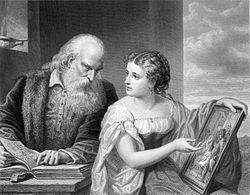
The late 19th century was a period of increased tension and conflict between science and religion; the relationship is dramatized in this engraving by W. Ridgway (published in 1878) after Daniel Huntington's 1868 painting Philosophy and Christian Art. An attractive young woman attempts to persuade a wizened natural philosopher of the virtue of Christian art (in the form of an adoration scene), while he resolutely points to his book, the pages of which read "SCIENTIA" and "MECHANICA", in answer. In addition to youth and beauty, the young woman has nature itself, seen through the window, on her side. (In the original painting, the landscape is a somewhat wilder Romantic scene, meant to emphasize the power of nature.)
Picture 33
Portal:History of science/Picture/33

ENIAC, short for Electronic Numerical Integrator and Computer, was the first large-scale, electronic, digital computer capable of being reprogrammed to solve a full range of computing problems, although earlier computers had been built with some of these properties. ENIAC was designed and built to calculate artillery firing tables for the U.S. Army's Ballistics Research Laboratory. The first problems run on the ENIAC however, were related to the design of the hydrogen bomb.
This photo has been artificially darkened, obscuring details such as the women who were present and the IBM equipment in use. The original photo can be seen in the article: Rose, Allen (April 1946). "Lightning Strikes Mathematics". Popular Science: 83–86. Retrieved 15 April 2012.
Picture 34
Portal:History of science/Picture/34
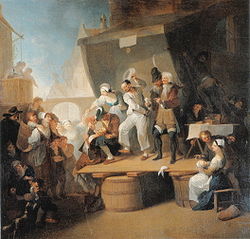
Der Quacksalber (The Quack) is a painting (oil on wood, 53 x 56 cm) by Franz Anton Maulbertsch, from some time before 1785. The subject, of course, is quackery—the peddling of unproven, and sometimes dangerous, medicines, cures or treatments— which has existed throughout the history of medicine. In ancient times, theatrics were sometimes mixed with actual medicine to provide entertainment as much as healing. Quack medicines often had little in the way of active ingredients, or had ingredients which made a person feel good, such as what came to be known as recreational drugs. Morphine and related chemicals were especially common, being legal and unregulated in most places at the time. Arsenic and other poisons were also included.
Picture 35
Portal:History of science/Picture/35

"Fuji at Torigoe" is the eightieth woodblock print from One Hundred Views of Mt. Fuji by the Japanese ukiyo-e artist Hokusai. It depicts the observatory of the Calendar Bureau during the Edo period, with astronomers working on the roof, Mount Fuji in the background. According to Hokusai scholar Henry D. Smith II, the instrument is best seen as an indication of Hokusai's interest in Western science rather than a representation of Japanese astronomical practice.
Picture 36
Nominating or creating selected pictures
If you have a suggestion for future Selected pictures for this portal, please suggest them on the discussion page, or create them yourself. You can also suggest future Selected articles at Portal talk:History of science/Article. If you have any questions, contact User:Ragesoss or leave a message at WikiProject History of Science.
